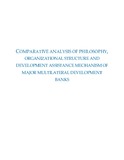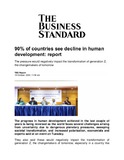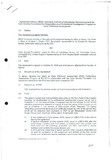| dc.description.abstract | This study examines the development assistance strategy and mechanism of five major multilateral development banks – The World Bank Group, The Asian Development Bank (ADB), The European Bank for Reconstruction and Development (EBRD), The Inter-American Development Bank (IADB) and The African Development Bank (AfDB).
Focus was given to the philosophy, structure and ownership; development assistance mechanism; avenues of consulting opportunities at different project cycle stages; procurement methods; strategic areas of priority (regional, sectoral and thematic); and emerging trends & strategic shifts of the organization that are relevant for development consulting firms as insights.
The World Bank Group remains the first and flagship multilateral development bank with more than US$ 50 billion new commitments per year and on an average 7-8 new invitation for bids to consulting firms per day. 16% share is owned by the USA, giving it absolute veto power as minimum requirement for change in mandate is 85% support. The three lending wings are IBRD – funding near market term loans to middle income and strong-governance countries, IDB – funding concessional term loans and grants to low income countries and IFC, investing in the private sector. IBRD and IDB combined is called the World Bank (Not to confuse with World Bank Group).
Study finds the procurement system and policies followed by World Bank Group has been emulated by almost all the other development banks in different degrees, (ranging from exact copying to adopting the same mechanism under different terminologies).
In 2013, WBG initiated a major strategic overhaul in two decades which involves - repositioning the bank as “One World Bank Group”, call for greater efficiency, more investment in knowledge and technical skills, enhanced cooperation and collaboration within the lending arms (IBRD-IDA-IFC-MIGA) and with other development partners. The goals set are to reduce extreme poverty to 3% by 2030 (interim goal of 9% by 2020 from baseline of 18% in 2010); and boosting bottom 40% of the population in developing countries. The new strategy also calls for “selective involvement” in “transformational projects”. The role of public-private partnerships has been stressed. Also the strategy suggests plans to transform into a leaner organization, reduction of bureaucracies and achieving administrative savings of $400 million. The new strategy identified that although the World Bank Group does not face immediate financial concerns, its financial capacity will need to be strengthened.
The priority sectors are identified as agribusiness, climate change and MSMEs. Priority region is Africa for World Bank. IFC on the other hand, invests highly in Latin America. In 2015, sector-wise, law and justice receives highest lending to World Bank, followed by Health and Social Services and Transportation. Rural Development and Human Development have been priority thematic areas in FY15 funding followed by Risk Management and Public Sector Governance. ii
Rural Development (18%) and Human Development (17%) was the thematic priority area for World Bank in 2013, followed by Social Protection and Risk Management (12%) and Public Sector Governance (11%).
The Asian Development Bank (ADB) is the next big multilateral bank with US$ 21 billion in investment and on average 1-2 new consulting opportunities being published daily. The procurement system is identical to that of World Bank. Japan holds the highest voting share with USA only nominally behind, the other two major shareholders are China and India. ADB was founded by Japan as it felt it was not being able to further its mandate through World Bank Group.
ADB’s current strategy is Strategy 2020 developed in 2008 focusing on inclusive economic growth, environmentally sustainable growth and regional integration. The drivers of change as identified in the strategy are: private sector development, good governance and capacity building, gender equity, knowledge solutions and partnerships. The five operational areas targeted towards gradually increasing 80% share of fund allocation by 2020 are Infrastructure, Environment, Regional cooperation and integration, Finance and Education. Also, ADB wants to scale up private sector operation to 50% by 2020 which in 2013 was 41%. Climate change and regional cooperation and integration activities are targeted to be at least 30% of total activities by 2020. Further breaking down the most preferred sector Infrastructure, the areas of interest to ADB in the long-term are clean energy, energy efficiency, sustainable transport, cross border integration and regional trade infrastructure and disaster and risk mitigation. In education sector, the renewed focus is on tertiary education, technical education and vocational education as deemed instrumental in increasing productivity, employability and innovation by ADB. PPP is an institutional priority to ADB. ADB also is envisioning higher degree of collaboration with other development partners. The target is to have total annual direct co-financing exceed the value of standalone ADB financing by 2020. The mid-term review of 2008-2012 period reveals ADB made quite good progress towards the envisioned ‘to-be’ state of 2020.
In 2015, portfolio of assistances were in Southeast Asia 30%, South Asia 28% and Central and West Asia 26%. Sector-wise, Energy 27% and Transport 24% were the highest recipient sector
The European Bank for Reconstruction and Development (EBRD) is the newest MDB focusing on supporting democratic development in former soviet bloc countries. It’s the only MDB with a stated political mandate. USA is the major shareholder in EBRD, making EBRD a misnomer. The EBRD's focus today is fostering stability in the countries of the Balkans, Georgia and the other countries of the Caucasus, and Central Asia; and in helping countries such as Ukraine and Russia to stay the course as a market-oriented economy that is nurturing the kind of middle class that strengthens democracy and economic growth. EBRD issues 0-1 new consulting opportunities on average per day with close to US$15 billion yearly commitments. iii
The EBRD is at a strategic crossroads because it has achieved much of its original mission of assisting formerly communist countries transition to market-based economies. Now, the EBRD must choose either expanding to countries beyond its original mandate or simply fading away and becoming a smaller and more focused institution as its original mandate is fulfilled.
The Inter-American Development Bank (IADB) is different from other MDBs in that the borrowing nations combined has enormous decision making power and ownership share. MDB also differs in that it focuses on social sector projects rather than large infrastructure projects. The procurement methods, mechanisms and policies are identical to that of the World Bank. IADB issues 0-1 new consulting opportunities on average per day with close to US$14 billion yearly commitments.
In 2010, The IDB Board of Governors agreed to increase the Ordinary Capital by $70 billion to enable the IDB to meet an increased demand for development lending. Coupled with this historic expansion of resources, the Bank has carried out a broad reform agenda. The bank has strengthened its focus on increasing accountability and integrity and pairing learning and accountability tools. The stated strategic priorities are: reducing poverty and social inequalities, addressing the needs of small and vulnerable countries, fostering development through the private sector, addressing climate change, renewable energy and environmental sustainability and promoting regional cooperation and integration. IADB also focuses on collaboration and has signed recent deals with the ADB and the World Bank Group.
Data analysis from FY15 Annual report reveals 37% assistance going to Mexico and 14% going to Uruguay and 7% to multi-country regional projects. The other countries received somewhat between 3-5% of rest of the assistance. Institutional Capacity & Finance 36% and Infrastructure & Environment 34% are two priority sectors as per FY15 data.
The African Development Bank (AfDB) has a stated mission to promote sustainable economic growth and reduce poverty in Africa. AfDB also issues 0-1 new project opportunities on average daily. AfDB has total allocated fund of US $6.7 billion in 2015.
The African Development Bank Group has two other entities: the African Development Fund (ADF) and the Nigeria Trust Fund (NTF). The African Development Fund (ADF) is the concessional window of the African Development Bank (AfDB) Group. The ADF has the challenge of having nearly half its client countries as fragile states, and facing a situation where even stable economies can become fragile due to a single internal or external shock. The ADF contributes to poverty reduction and economic and social development in the least developed African countries by providing concessional funding for projects and programs, as well as technical assistance for studies and capacity-building activities. The Nigeria Trust Fund (NTF) was created in 1976 by agreement between the Bank Group and the Nigerian government. The NTF is a self-sustaining revolving fund. Its objective is to assist the development efforts of the Bank's low-income regional member countries whose economic and social conditions and prospects require concessional financing. iv
AfDB recently formulated their long term strategy paper for the period 2013 – 2022. The two objectives for the ten-year strategy are inclusive growth and green growth. The inclusive growth objective focuses on unlocking the demographic dividend, bringing prosperity to the base of the pyramid population and infrastructure and community participation. The green growth objective focuses on making growth sustainable, protecting livelihoods, improving water, energy and food security, promoting sustainable use of natural resources and spurring innovation, job creation and economic development. The five operational priorities identified are infrastructure development, regional economic integration, private sector development, governance and accountability and skill and technology. The areas of special emphasis are fragile states, agriculture and food security and gender.
AfDB’s priority sectoral priorities are Infrastructure and Agriculture and thematic priorities are in Infrastructure and Knowledge Products as per FY13 fund allocation. Congo received the highest amount of aid, surpassing others by large margin, followed by Kenya, Mali and Nigeria. | en_US |



